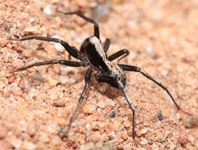Abstract
Three species of the genus Allophrys Förster are found to occur in Japan: A. matsumurai sp. nov., A. takemotoi sp. nov. and a third morphospecies known only from males. This is the first description of Allophrys species from Japan, as well as from the entire Palaearctic region. An identification key to Japanese species of Allophrys is provided.
References
Gauld, I.D. (1984) An Introduction to the Ichneumonidae of Australia. Bulletin of the British Museum (Natural History) (Entomology), 895, 1–413.
Horstmann, K. (2010) Revisions of Nearctic Tersilochinae II. Genera Allophrys Förster, Barycnemis Förster, Ctenophion gen. nov., Sathropterus Förster, Spinolochus Horstmann and Stethantyx Townes (Hymenoptera, Ichneumonidae). Spixiana, 33 (1), 73–109.
Horstmann, K., Floren, A. & Linsenmair, K.E. (2005) Ichneumonidae (Hymenoptera) from the canopy of tropical forests in Sabah, Malaysia: a comparison between primary and secondary forests. Ecotropica, 11, 41–52.
Khalaim, A.I. (2007) 17. Subfamily Tersilochinae. In: Lelej, A.S. (ed.), Keys to the insects of the Russian Far East, Vol. IV. Neuropteroidea, Mecoptera, Hymenoptera. Part 5. Dal’nauka, Vladivostok, pp. 566–597. [In Russian]
Khalaim, A.I. (2011) Tersilochinae of South, Southeast and East Asia, excluding Mongolia and Japan (Hymenoptera: Ichneumonidae). Zoosystematica Rossica, 20 (1), 96–148.
Khalaim, A.I. (2013a) Discovery of the South African fauna of Allophrys Förster (Hymenoptera: Ichneumonidae: Tersicochinae). Zootaxa, 3701 (3), 329–343.
https://doi.org/10.11646/zootaxa.3701.3.3Khalaim, A.I. (2013b) New data on the Afrotropical Tersilochinae (Hymenoptera, Ichneumonidae). Proceedings of the Russian Entomological Society, 84 (2), 129–136.
Khalaim, A.I. & Broad, G.R. (2012) Tersilochinae (Hymenoptera: Ichneumonidae) of Costa Rica, part 1. Genera Allophrys Förster, Barycnemis Förster and Meggoleus Townes. Zootaxa, 3185 (2), 36–52.
https://doi.org/10.11646/zootaxa.3693.2.8Townes, H.K. (1971) The genera of Ichneumonidae, Part 4. Memoirs of the American Entomological Institute, 17, 1–372.

